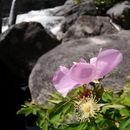tr
kırıntılardaki isimler


Rosa nutkana, commonly known as the Nootka rose, is an angiosperm of the Rosaceae family. The flowers typically have five large petals, growing to about 2.5 cm long in varying in shades of pink (Knoke and Giblin 2017). These petals form a single layered corolla, which is usually accompanied by five thin, green sepals that are often nearly as long as the petals (USDA 2017.) The pistils and stamens in the center of the flower make up a golden yellow ring, with the stamens completely surrounding the pistils. Rosa nutkana are perennial plants that bloom in the summer, from May to July (Knoke and Giblin 2017).
Subspecies of the Rosa nutkana include Rosa nutkana subsp. melina, Rosa nutkana subsp. nutkana, Rosa nutkana subsp. macdougalii, and at least one other which lacks an official name (Flora of North America 2017). Most Rosa nutkana have thorns as a defense mechanism, and most subspecies have straight thorns or lack them, save one which has curved thorns. The plant takes the form of a shrub with thin, tangled, dark stems growing up to 2 meters in height (USDA 2017). Its leaves are bright green and pinnately compound (Alden 1998). Both the leaves and the hips, containing the seeds, are deciduous, and the fruit is ripe from August to September. The hips are particularly palatable for deer, elk, and squirrels (Reed 1993).
Native to the Pacific Northwest, Rosa nutkana resides at elevations below 2.3 km west of the Cascade Crest, along the Pacific Coast from Alaska to Northern California. It thrives in moderately wet climates, frequently occurring in floodplains, meadows, and streambanks (Reed 1993). It also tends to grow sporadically in open-canopy forests as an understory plant. Forest communities in which Rosa nutkana can be commonly found include: Douglas-fir, Ponderosa pine, Mountain hemlock, Sitka spruce, Lodgepole pine, Redwood, and estern hardwoods (Pavek and Skinner 2013). It can also be found growing near red osier dogwood, quaking aspen, black cottonwood, and snowberry (USDA 2017).
Rosa nutkana is generally an adaptable plant, and because of this, it is very abundant (Knoke and Giblin 2017). It can exist in a wide range of pH environments, but grows best between pH values of 5.6 – 7.0. It prefers sunny areas with well-drained, nitrogen-rich soil and thrives in clayey-loam, sandy-loam, or sandy soils (Reed 1993). It is sensitive to drought, but can recover from fire relatively well (USDA 2017).